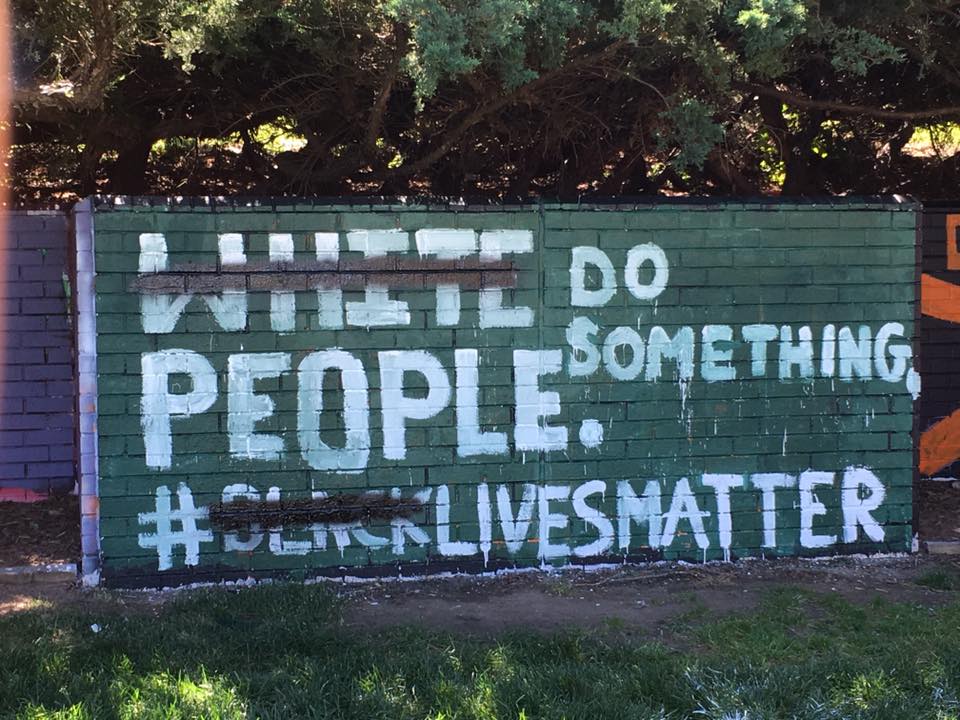DU’s graduate Black Student Alliance (BSA) created art on the free speech wall on campus at the beginning of the quarter to show solidarity for the Black Lives Matter movement and to mourn the lives lost to police brutality this year. Twice, within two weeks, that message has been defaced.
There’s a lot of conversation and disagreement around the issue of the defacing of the wall. Some claim it’s simply a form of free speech, while others say that vandalizing and silencing someone else’s speech should be punished.
The fact of the matter is that the messages that covered up the art on the wall, particularly the message and song lyrics from “Guilty of Being White” by Minor Threat, “Guilty of being white. Guilty of being right,” is directly harmful to students of color at DU. Therefore, their voices are the ones that need to be heard.
BSA president, sophomore Makia Jones, and vice president, sophomore Tashan Montgomery, explained how many black students on campus feel about the current racial climate at DU. They said that it goes beyond the defacing of the wall and that this tension has been evident to them since they first began classes their freshman year.
Jones stated that she is “consistently conscious that she is of the non-white minority” while on DU’s campus.
“It’s not to say that the white majority of students here on campus are attacking us on a daily basis, but they’re not doing anything to protect us either and I think that is almost equal to being a part of the struggle that we’re facing,” said Jones.
“Definitely [in reference to Jones’ statement]. There are individual cases I could talk about, but as an institution [DU], I do not feel supported at all and I’m disappointed that the university allows this type of behavior to continue to happen. This is the fourth time in 2016 that a wall showing solidarity for Black Lives Matter has been defaced. The fact that the university hasn’t done anything shows me that they want to stay neutral on it,” said Montgomery.
Jones also spoke of the lack of resources that DU provides for students of color.
“They [DU] have provided some resources here and there for students of color to have outlets to talk about their experiences at DU, but we have to find it ourselves. We need someone dedicated to listening to the problems of students of color, helping them process and helping them get to a better mental state. This climate truly does take a toll on us—or at least myself—on a daily basis,” said Jones.
“It’s a constant battle,” Montgomery said. “Being a black student at a predominately white institution, you have to deal with racist students, you have to deal with racist comments on social media, particularly Yik Yak. You have to deal with all of this while you’re trying to keep good grades, while you’re trying to keep a stable mental health and stay happy, while you’re trying to balance finances and stay at a university so you can use your education and do something better for your community. It all falls back on us. We’re paying to go to a school and we have to fix these racist issues too? It’s a struggle.”
Students and faculty members have come up with a few solutions to the problems they face at DU, some of which include having a mentor or advisor for students of color, education on power and privilege in the classroom and increasing diversity among faculty and students.
Diversity is a huge problem within DU. Data gathered from Center for Multicultural Excellence states that there are only 135 black students out of the 5,758 students in the undergraduate program. There were 22 in the class of 2019, but six to seven students from the class have already transferred.
“You know it’s bad when I’m not stressed because of midterms, but I’m stressed because I’m going to school with these racist students who are running around dismissing people trying to honor dead bodies. That’s what’s stressing me out. As long as this culture exists at this school, then of course your students of color numbers are going to be low. Because this is not an inviting campus,” said Montgomery.
Jones agreed to Montgomery’s statement regarding tension on campus.
“I knew DU was a predominately white institution, as a majority of universities in the United States are, but if I had known that this was the racial climate at DU, there’s not a chance I would be here. There’s no way I would choose to put myself through this stress,” said Jones.
The DU student body can argue over whether or not the defacing of the wall was simply an act of “free speech” all they want, but it is DU’s students of color who are hurting the most from this event.
As a Native American student, and as someone who is allying herself to the black students here on campus, I am asking for people to listen to the voices of those affected. We need unity and we need action, but we also need a space in which we simply listen to the hurt, the fear and the anger of those who are suffering. Listen to understand, not to speak. Only then can we move forward as a community to come together and make the differences our campus so desperately needs.










